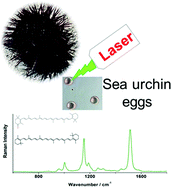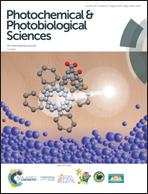Microsphere packages of carotenoids: intact sea urchin eggs tracked by Raman spectroscopy tools†
Abstract
Although natural exposure to ambient UV radiation in oligotrophic seawater at small depths can reach the levels responsible for cellular damage, the sea urchin Paracentrotus lividus is frequently in such sites, particularly on the southern Adriatic Sea shore. Spawning their eggs and spending their early life stage in rocky shores at depths of 0.5–2 m are the results of their successful adaptation strategies, although adults may dwell at greater depths. Surprisingly, there is a paucity of reports regarding the carotenoid content in sea urchin eggs. Beyond their important role in photoprotection against high UV exposure, cell division and early development, the content and distribution of carotenoids contribute to the successful survival of sea urchins and also determine the color of their gonads (roe), which is of commercial importance as a delicacy. Herein, for the first time, we have described the carotenoid content and distribution in intact, freshly released eggs of P. lividus species, non-destructively employing resonance Raman spectroscopy and imaging; near-infrared Raman spectroscopy revealed additional molecular carotenoid content. Echinenone and β-carotene resonance Raman signals were the most intense, and they were identified as the principal carotenoids that are preferentially accumulated in eggs rather than in gonads. Raman imaging in confocal mode revealed the uniform distribution of the carotenoid signal over the whole eggs, while the distribution of proteins appeared spotted. Egg carotenoids generally maintained their identity after 2 months of dry storage, with slight signs of C![[double bond, length as m-dash]](https://www.rsc.org/images/entities/char_e001.gif) C bond oxidation. The potential utilization of P. lividus sea urchin eggs as valuable microsphere packages of native carotenoids is discussed.
C bond oxidation. The potential utilization of P. lividus sea urchin eggs as valuable microsphere packages of native carotenoids is discussed.



 Please wait while we load your content...
Please wait while we load your content...